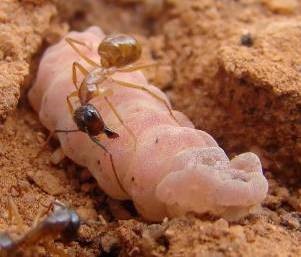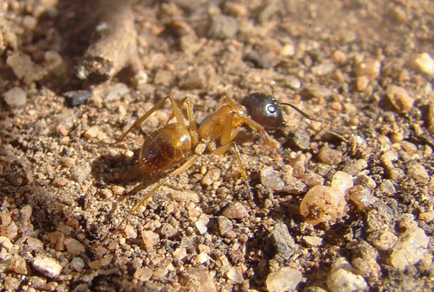The Ants and the Butterfly



For a number of years it was thought that the Arid Bronze Azure Butterfly (Orgyris subterrestris) had become extinct. But, recently a butterfly enthusiast stopped for a roadside break near a nature reserve in Mukinbudin. A flash of colour caught his eye. The butterfly he sighted was later confirmed as being the elusive Arid Bronze Azure Butterfly.
The Arid Bronze Azure Butterfly has a wing span of about 5cm with a blue tinge above each
wing. The female has an added white spot above the blue tinge which can be seen on either side of the wing. These butterflies may be seen flying from September to may with numbers usually peaking in mid spring and late summer.
The Arid Azure Bronze Butterfly shares a remarkable relationship with Sugar ants. The female butterfly will lay its eggs near a sugar ant’s nest. After hatching, the larvae will be taken inside the ant nest where it will then be protected. In return the larvae will supply the ants with sugary nectar it stores in special glands on its body. It will eventually leave the nest to form a cocoon and become an adult.
The Mukinbudin Conservation Group was involved in the rediscovery of this unique species in a patch of bushland just west of the Mukinbudin town site. The Mukinbudin Conservation Group (MCG) applied to Wheatbelt NRM in 2010 for a Small Community Grant to design a garden of specifically propagated native species. The garden complements and extends the Regional Herbarium. Sturdy metal sculptures (made especially for the outdoors by local metal work artist) depicting the life story of the butterfly, the ant and the leafhoppers were designed, constructed and installed. The Mukinbudin Shire erected a rock wall and laid paving for the regional Herbarium garden. A children’s book, written by Catilin Moloney was produced.



The Ants and the Butterfly Book can be purchased from the Mukinbudin Community Resource Centre.
This story is based in the life history of a very rare and endangered butterfly, the Arid Bronze Azure, which is known only from a small woodland near the town of Mukinbudin.
See The Wheatbelt Natural Resource Management Website for more information about this spectacular creature.